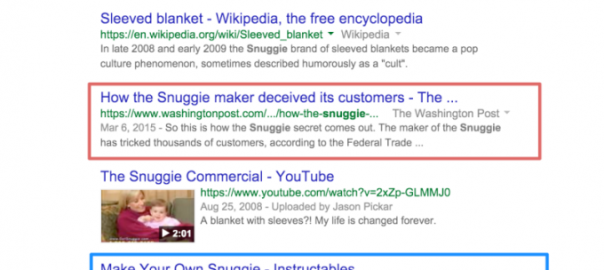Having trouble showing progress when it comes to online reputation management (ORM)? Columnist Brian Patterson explains his metric for tracking ORM campaign progress over time.

It’s something all companies fear: You Google your brand name, and right on the first page are negative Google reviews, a low Yelp score, damaging articles or — possibly worst of all — a Ripoff Report post.
The thought of this setback is enough to make any good marketer break out in a cold sweat. But for many of us, this is just another SEO challenge we face, albeit under a slightly different name: Online Reputation Management.
Imagine you are the marketing genius behind the iconic Snuggie. You Google your brand, see the following results and are rightly concerned:

In these results, you can see a few clearly negative search results from big news sites (boxed in red). There are also two blog posts that you might consider neutral (boxed in blue). These neutrals aren’t the worst things in the world, but they aren’t glowingly positive, either.
Just two negative articles appearing in the search results for a product can cost you up to 44 percent of potential customers, so this is definitely an issue to address, as it could be significantly impacting online sales.
Is It Off Page One?
As with every project, we want to start by capturing a baseline starting point and determining how we will report improvement over time.
Tracking progress for an online reputation management (ORM) project like this can be complex. Instead of tracking a single domain for a large set of keywords (as with SEO), we are tracking multiple URLs for a smaller set of branded keywords. So while SEO metrics are well established, ORM metrics are almost always custom-defined for the client and project.
The initial focus of a reputation management project with a client is almost always, “Is it off page one?”
While that is a valid question, completely cleaning the search engine results pages (SERPs) for a brand name can take months. And in that time, if you are only focused on a binary yes/no result, you miss out on how improvements or setbacks are impacting your brand.
This binary question misses some of the nuances of the search results (namely, their ranking positions). As we know, ranking position impacts user visibility and click-through rate.
Because of this challenge, we built a SERP Sentiment score to measure branded SERPs based on the number of positive, negative and neutral URLs that appear on page one, along with what positions each of those occupy.
This score helps you see and report the progress of your reputation management campaign on a daily and weekly basis — the type of progress that isn’t noticed if you focus on the binary result of, “Is it off page one?”
[Read the full article on Search Engine Land.]
Some opinions expressed in this article may be those of a guest author and not necessarily Marketing Land. Staff authors are listed here.
(Some images used under license from Shutterstock.com.)
Marketing Land – Internet Marketing News, Strategies & Tips
(52)









